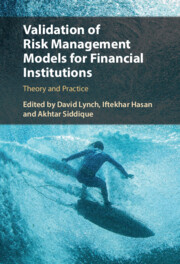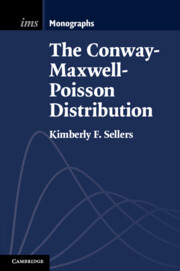Refine search
Actions for selected content:
52379 results in Statistics and Probability
Frontmatter
-
- Book:
- Data Management for Social Scientists
- Published online:
- 03 March 2023
- Print publication:
- 09 March 2023, pp i-iv
-
- Chapter
-
- You have access
- Open access
- Export citation
Covid-19 and the effectiveness of ERM frameworks
-
- Journal:
- British Actuarial Journal / Volume 28 / 2023
- Published online by Cambridge University Press:
- 08 March 2023, e1
-
- Article
-
- You have access
- Open access
- HTML
- Export citation
Sandwiched SDEs with unbounded drift driven by Hölder noises
- Part of
-
- Journal:
- Advances in Applied Probability / Volume 55 / Issue 3 / September 2023
- Published online by Cambridge University Press:
- 08 March 2023, pp. 927-964
- Print publication:
- September 2023
-
- Article
- Export citation
An ergodic theorem for asymptotically periodic time-inhomogeneous Markov processes, with application to quasi-stationarity with moving boundaries
- Part of
-
- Journal:
- Advances in Applied Probability / Volume 55 / Issue 2 / June 2023
- Published online by Cambridge University Press:
- 08 March 2023, pp. 672-700
- Print publication:
- June 2023
-
- Article
- Export citation
Cumulative and undiagnosed SARS-CoV-2 infection among the staff of a medical research centre in Tokyo after the emergence of variants
-
- Journal:
- Epidemiology & Infection / Volume 151 / 2023
- Published online by Cambridge University Press:
- 08 March 2023, e48
-
- Article
-
- You have access
- Open access
- HTML
- Export citation
On hybrid tree-based methods for short-term insurance claims
-
- Journal:
- Probability in the Engineering and Informational Sciences / Volume 37 / Issue 2 / April 2023
- Published online by Cambridge University Press:
- 08 March 2023, pp. 597-620
-
- Article
-
- You have access
- Open access
- HTML
- Export citation
An efficient method for generating a discrete uniform distribution using a biased random source
- Part of
-
- Journal:
- Journal of Applied Probability / Volume 60 / Issue 3 / September 2023
- Published online by Cambridge University Press:
- 07 March 2023, pp. 1069-1078
- Print publication:
- September 2023
-
- Article
- Export citation
A network community detection method with integration of data from multiple layers and node attributes
-
- Journal:
- Network Science / Volume 11 / Issue 3 / September 2023
- Published online by Cambridge University Press:
- 07 March 2023, pp. 374-396
-
- Article
- Export citation
Degree distributions in recursive trees with fitnesses
- Part of
-
- Journal:
- Advances in Applied Probability / Volume 55 / Issue 2 / June 2023
- Published online by Cambridge University Press:
- 06 March 2023, pp. 407-443
- Print publication:
- June 2023
-
- Article
- Export citation
Epidemiology of invasive meningococcal disease worldwide from 2010–2019: a literature review
-
- Journal:
- Epidemiology & Infection / Volume 151 / 2023
- Published online by Cambridge University Press:
- 06 March 2023, e57
-
- Article
-
- You have access
- Open access
- HTML
- Export citation

Data Management for Social Scientists
- From Files to Databases
-
- Published online:
- 03 March 2023
- Print publication:
- 09 March 2023
-
- Book
-
- You have access
- Open access
- Export citation
Validating the behavioral Defining Issues Test across different genders, political, and religious affiliations
-
- Journal:
- Experimental Results / Volume 4 / 2023
- Published online by Cambridge University Press:
- 03 March 2023, e6
-
- Article
-
- You have access
- Open access
- HTML
- Export citation
A model for an epidemic with contact tracing and cluster isolation, and a detection paradox
- Part of
-
- Journal:
- Journal of Applied Probability / Volume 60 / Issue 3 / September 2023
- Published online by Cambridge University Press:
- 03 March 2023, pp. 1079-1095
- Print publication:
- September 2023
-
- Article
- Export citation
Chinese oats in temperate Bhutan: Results of field experiments
-
- Journal:
- Experimental Results / Volume 4 / 2023
- Published online by Cambridge University Press:
- 03 March 2023, e9
-
- Article
-
- You have access
- Open access
- HTML
- Export citation

Validation of Risk Management Models for Financial Institutions
- Theory and Practice
-
- Published online:
- 02 March 2023
- Print publication:
- 09 March 2023

The Conway–Maxwell–Poisson Distribution
-
- Published online:
- 02 March 2023
- Print publication:
- 09 March 2023
Characteristics, treatment and care of pregnant women living with hepatitis B in England: findings from a national audit
-
- Journal:
- Epidemiology & Infection / Volume 151 / 2023
- Published online by Cambridge University Press:
- 02 March 2023, e50
-
- Article
-
- You have access
- Open access
- HTML
- Export citation
On the probability of rumour survival among sceptics
- Part of
-
- Journal:
- Journal of Applied Probability / Volume 60 / Issue 3 / September 2023
- Published online by Cambridge University Press:
- 02 March 2023, pp. 1096-1111
- Print publication:
- September 2023
-
- Article
- Export citation
Is remote measurement a better assessment of internet censorship than expert analysis? Analyzing tradeoffs for international donors and advocacy organizations of current data and methodologies
-
- Journal:
- Data & Policy / Volume 5 / 2023
- Published online by Cambridge University Press:
- 02 March 2023, e9
-
- Article
-
- You have access
- Open access
- HTML
- Export citation
An iterative regulatory process for robot governance
-
- Journal:
- Data & Policy / Volume 5 / 2023
- Published online by Cambridge University Press:
- 01 March 2023, e8
-
- Article
-
- You have access
- Open access
- HTML
- Export citation






